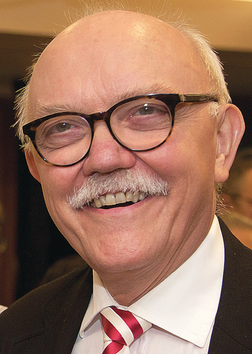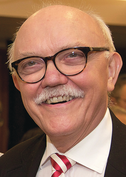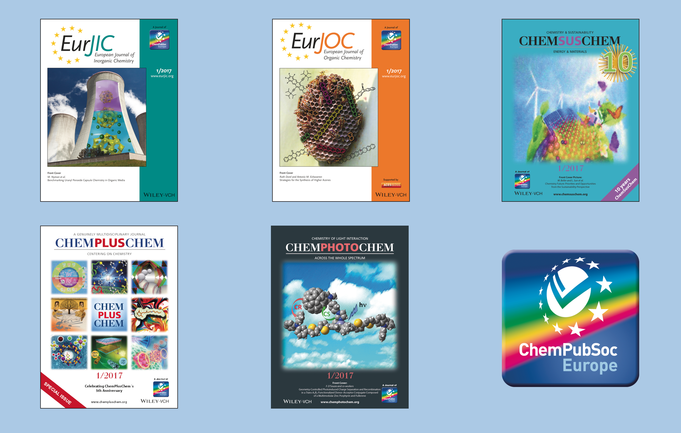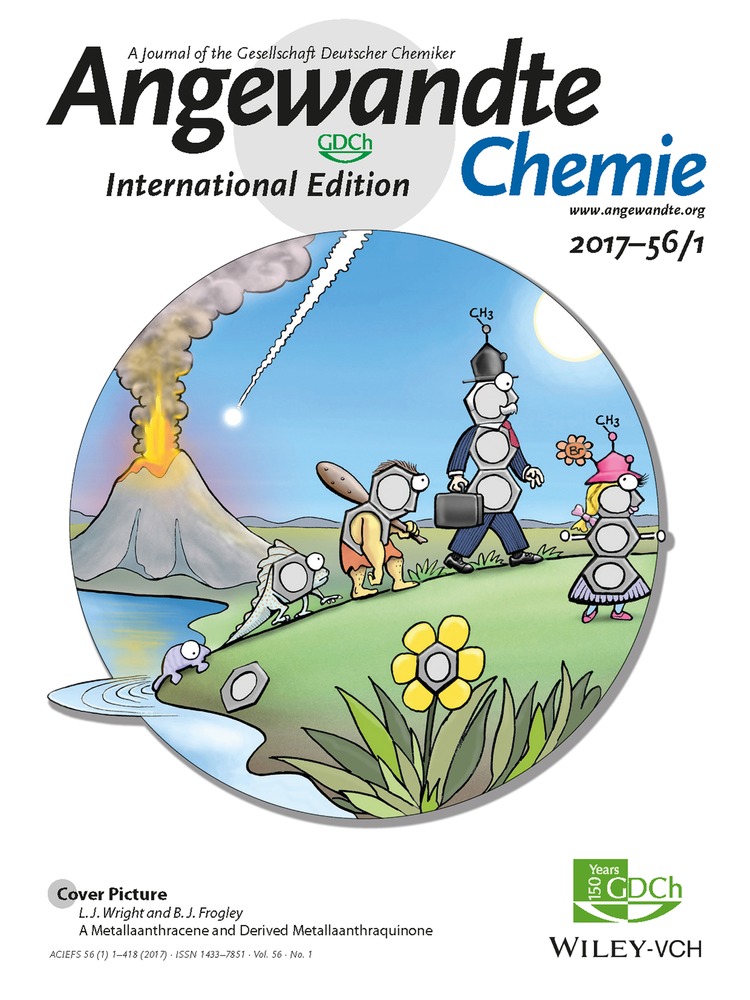150 Years of the German Chemical Society (GDCh), New Board Members, and More
Graphical Abstract
Should manuscripts by young authors with low H indices be directly rejected? Such crazy ideas can be extrapolated from the notion that lots of citations are a guarantee for high quality. Such flawed developments in scientific publishing are one theme of the Editorial by the Editor in Chief of Angewandte Chemie, as are far more positive aspects, such as the activities of the German Chemical Society (GDCh; Gesellschaft Deutscher Chemiker) in it anniversary year, 2017.
The GDCh has planned numerous activities for 2017, details of which can be found in the member's magazine Nachrichten aus der Chemie, on the GDCh Homepage, and on Chemistry Views. The high point will by the GDCh-Science Forum Chemistry (GDCh-Wissenschaftsforum Chemie (see Figure 1), that takes place under the motto “Chemistry Moves” (Chemie bewegt) on 10th–14th September in Berlin. It will be opened with a ceremony on Sunday 10th September in the Konzerthaus am Gendarmenmarkt, which will include a lecture by Nobel Laureate Roald Hoffmann, who has been a member of Angewandte Chemie’s International Advisory Board for many years. On Monday, 11th September the celebrations continue with an Angewandte Symposium in the Henry Ford Building of the Free University of Berlin. This symposium will have the same character as the highly successful Angewandte Symposium to celebrate 125 years of Angewandte Chemie in 2013; the list of speakers, which include the four Nobel Laureates Ben Feringa, Bob Grubbs, W. E. Moerner, and Jack Szostak, promises excellent lectures on important current themes (see Figure 2). On the two following days the normal Science Forum continues with a multifaceted lecture program covering all aspects of chemistry. Celebrations end with another highlight: on Thursday 14th September is the symposium “Experiment Zukunft—Wertedenken in der Chemie” (Experiment Future—Value Thinking in Chemistry); it is about nothing less than the future of mankind and the contribution that Chemistry not only can, but must make. Angewandte Chemie will be publishing a special issue to accompany the Anniversary Symposium which will include a Review on the history of the German Chemical Society from 1867–1945 and articles by speakers of the Angewandte Symposium.
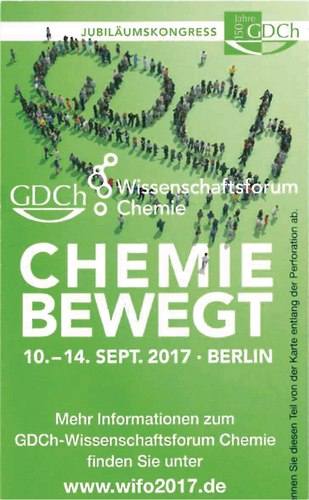
Announcing the GDCh Anniversary Congress 2017.
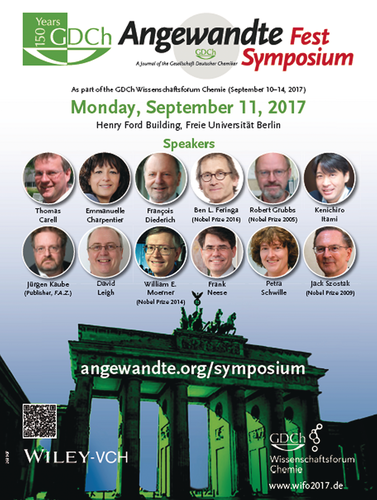
Announcing the Angewandte Symposium on 11th September 2017 in Berlin.
As well as the German Chemical Society, in 2017 the Royal Australian Chemical Institute (RACI) and the Canadian Society for Chemistry (CSC) celebrate landmark anniversaries: From 28th May–1st June the 100th Canadian Chemistry Conference and Exhibition takes place in Toronto, and from 23rd–28th July in Melbourne the RACI has organized an impressive Centenary celebration; in that week eight conferences take place in one place, including the 17th Asian Chemical Congress, incorporating an ACES-GDCh-Symposium on the Chemistry of Nanomaterials (27th July). Angewandte Chemie is joining in the celebrations with German–Australian and German–Canadian special issues, which will also emphasize the close links between the German Chemical Society and chemical societies from all over the world.
While I am writing this Editorial I am looking forward to “Stockholm”, where next week I will be taking part in the 2016 Nobel Prize Ceremony. Ben Feringa, Jean-Pierre Sauvage, and Sir Fraser Stoddart have made fundamental contributions to chemistry and stimulated huge numbers of chemists with their publications; they have pushed the door to the chemistry of molecular machines wide open. The Nobel Prize makes scientists immortal, but not as real people. Unfortunately in 2016 Harry Kroto, Roger Tsien, and Ahmed Zewail died (Obituaries were published in Issues 37, 38, and 45), three charismatic chemists whose names will forever be associated with fullerene chemistry, biological imaging, and femtochemistry, respectively. Their appearances at lectures in our publishing house in Weinheim for young European chemistry students (H. Kroto), at the symposium in Paris to celebrate 10 years of ChemBioChem and ChemPhysChem (R. Tsien), and at the Angewandte Symposium in Berlin (A. Zewail) will always be remembered.
Now to scientific publishing and Angewandte Chemie: Articles describing genuine successes but also informative failures stimulate both individual readers and the whole of chemistry. In contrast, the seemingly infinite number of manuscripts reporting already established, or minimal variations, or incomplete, or even unprofessional work create an enormous smoke screen that hinders the progress of science. Unfortunately, is it the case that every manuscript that is written will be published, regardless of the quality of the research described; a great many dubious journals make their living from manuscripts that did not pass the peer-review process at well-respected journals. Of particular concern is that some journals deliberately take names reminiscent of established ones, to mislead authors. For example, as well as the journals of ChemPubSoc Europe, Chemistry—A European Journal and ChemistryOpen, there is now a European Journal of Chemistry and an Open Chemistry, which have nothing at all to do with the chemical societies behind ChemPubSoc Europe. There are not only copycats among the scientific journals, there are also some “services” upstream, that want to make money out of authors before they submit a manuscript. After publication of my Editorial in Issue 44/2016 I received the following offer: “You are receiving this e-mail because you are a published author in Angewandte Chemie and in the belief it is of interest to you. The Journal has been selected for inclusion in …—a tool designed to enable non-native English speakers to write science research for publication in English. Because you are a contributor to the Journal we offer you a custom subscription—your Contributor's Code is …” With this standard of English, their service seems to be less than useful. However, there are reputable companies that offer genuine help with writing manuscripts. Once manuscripts have been written or submitted, again new services are mushrooming; they want to help downstream in the peer-review process or in generating further publicity (or noise) for authors—there is a price for all this.
In 2016 Angewandte Chemie received (Figure 3), in addition to the many manuscripts for other rubrics, nearly 12 000 Communications, of which approximately 2570 were published after careful peer review and editing. Figure 4 shows the number of articles published in Angewandte Chemie and in other journals belonging to chemical societies. Approximately 9500 Communications were rejected in total in 2016, 4800 of which directly by the Editors; a large proportion of these describe work that although carefully performed, was considered to be only of interest to a specialist community. However, there are also manuscripts which provoke the question, why on earth has the author submitted this? It seems that standards are eroding, but also the pressure to publish in high Impact Factor journals has increased to the extent that even renowned scientists can be led astray. Recently someone offered us a Review article on an aspect of drug delivery that was clearly far too specialized for Angewandte Chemie, although such publications are currently highly fashionable and highly cited. We declined the offer and recommended publication in a sister journal catering specifically to the manuscript's target audience. The author replied “The pity is that we depend massively on high impact journals for obtaining research funding and scholarships. Therefore, I can't accept your offer…”. This sort of reply is far from unique! Typical is also the reaction of an author whose manuscript was rejected directly because as well as being too specialized it was also far too long; they angrily pointed out how high their H index was and the impressive number of citations their over 200 publications had accumulated, which in their opinion showed that the new manuscript must also be interesting enough to be sent to referees. Following this type of reasoning should we thus reject all manuscripts from young authors with a low H index and few citations? We assess every new manuscript without prejudice, it is the results in that manuscript, and that alone that counts.
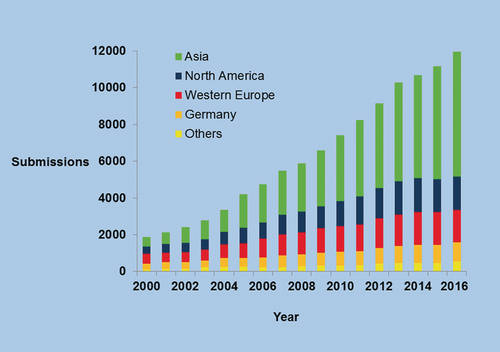
Number of Communications submitted to Angewandte Chemie per year since 2000 and their region/country of origin. Not included are Reviews, Minireviews, Essays, Highlights, Book Reviews, and other rubrics. The number for 2016 is extrapolated on the basis of the first 11 months.
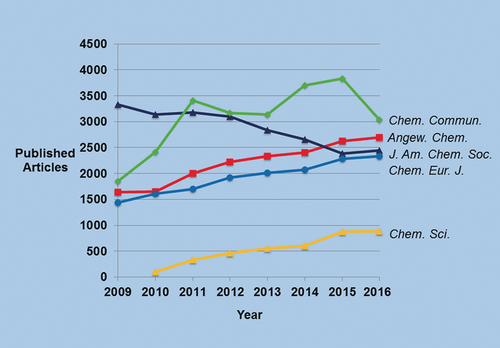
The development of the number of articles published by general-chemistry journals that are owned by chemical societies. Chemical Communications and Chemical Sciences are published by the Royal Society of Chemistry. The name Journal of the American Chemical Society is self-explanatory, Angewandte Chemie is owned by the German Chemical Society (Gesellschaft Deutscher Chemiker; GDCh), and Chemistry—A European Journal is owned by a consortium of 16 European chemical societies. The numbers for 2016 are extrapolated on the basis that 90 % of the Issues for the year have been published. Source: Web of Science.
What is new for 2017? With immediate effect all authors have to give information as to whether there is a (financial) conflict of interest, for example, when a company may profit from the publication of a manuscript in Angewandte Chemie and an author of the manuscript in question is also involved with the company. In addition, and also with immediate effect, authors are explicitly required to list the individual contributions made by each author—who did what? The responsibilities and the expertise are thus clearly assigned, which brings many advantages, even when it may not always be easy to breakdown each person's role, and will hopefully reduce the numbers of unjustified authorships.

From right to left: Roland A. Fischer, Brigitte Voit, Phil Baran, Holger Braunschweig, Rainer Haag, Kenichiro Itami.



